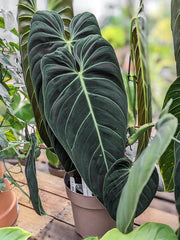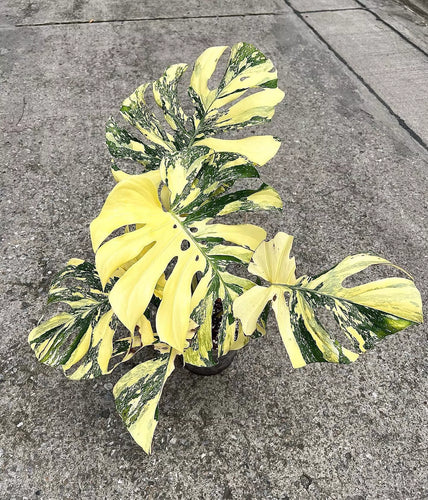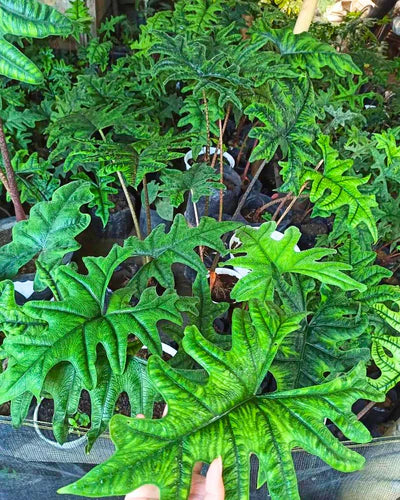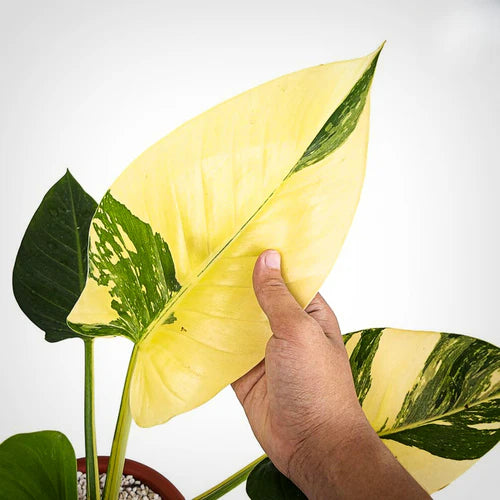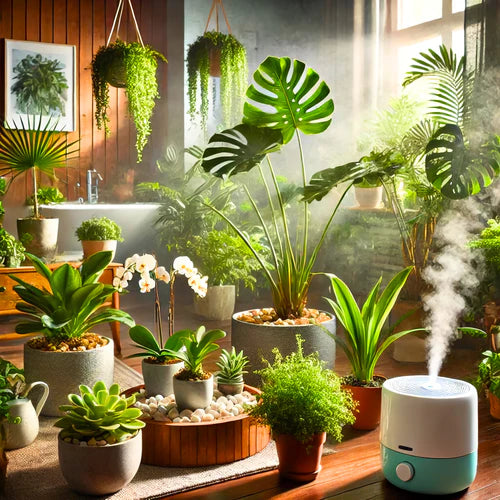Monstera Thai Constellation Care Guide
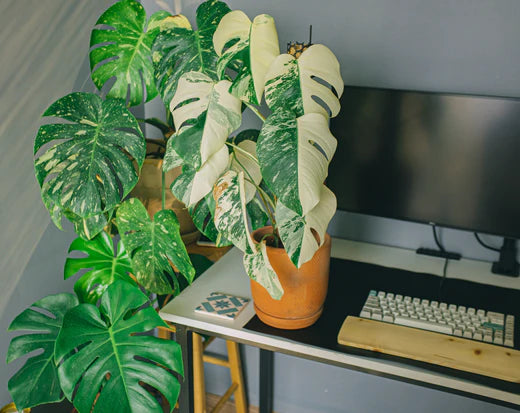
The Monstera Thai Constellation is a spectacular houseplant that will capture anyone's attention with its dramatic and beautiful variegated foliage. This plant is known for its appealing variegated leaves that feature splashes of creamy-yellow coloration, which give it a unique and eye-catching appearance with each new leaf being different.
The leaves of this plant start off small and heart shaped in their juvenile form then grow into enormous, glossy, and fenestrated when more mature. They change their leaf structure as they age and grow up a support.
You might be surprised to know that the origin of this yellow-to-white variegated plant was created in a lab! Specifically in a tissue culture laboratory in Thailand. The parent plant from which it was developed is the Monstera Deliciosa, which is known for its large, tropical leaves.
One fun fact about this tropical plant is that it gets its name from the pattern of variegation on it's foliage, which resembles a celestial constellation. It's not hard to see why, as the unique variegation of the leaves gives the plant an otherworldly appearance. If you're interested in growing this kind of variegated Monstera, it is moderately easy to take care of.
It needs bright, indirect light, very chunky/airy aroid mix, good humidity and regular fertilizing. Also, since it's a climbing plant, it will need a support structure like a trellis or a moss pole to allow its aerial roots to cling to and produce bigger, more fenestrated leaves.
Overall, the Monstera Thai Constellation is a plant that will add a touch of elegance and awe to any indoor space with its distinctive variegated leaves and constellation-like leaf pattern. A must have for any Monstera lover or houseplant collector.
Read below to find out more about how the basics of taking care of this variegated beauty!
Monstera Thai Constellation Plant Care Guide:
Here are some quick tips to understand the basic care:
Botanical Name: Monstera Deliciosa
Another name: Monstera Deliciosa Thai Constellation, Variegated Monstera Deliciosa, Variegated Monstera
Plant type: Slow to medium growing
Exposure to sunlight: Plenty of bright indirect light
Soil type: Well-draining and very chunky soil
Color: Green and yellow-to-white variegation
Water: Less watering
Favorable climate: Tropical & Humid
Preferable Fertilizer: Liquid fertilizer
Propagation: Stem cuttings with node - air layer for best results
Toxicity warning: Toxic if ingested
Status: Rare
Height: 6m tall
Origin: Laboratory in Thailand
Now that you've gotten a quick overview of this rare Monstera, we will give you important tips, do’s, and don'ts with growing this coveted plant.
Thai Constellation Soil Mix:
Monstera Deliciosa ‘Thai Constellation’ should be planted in a nutrient-rich, well-draining soil mix. It’s essential to keep the soil moist but not soggy or mushy as they are very prone to root rot!
A high-quality indoor potting mix with orchid bark, perlite, pumice, coconut chips and or sand will assist greatly improve drainage. Remember that dense, heavy soil is a big no-no and will rot your Thai's roots!
You can add other organic materials such as coco coir, mulch chunks and coconut husk to the soil to help restrain moisture. Adding worm castings or garden compost will add more richness to the soil which this plant will love.
Monstera Thai Constellation Watering:
The Monstera "Thai Constellation" has extremely delicate roots that are easy to rot. Therefore, when watering your Monstera, be sure to water thoroughly and then properly drain the water. Never allow the soil to become completely dry or wet. Both are harmful to the health of the plant. If you normally have trouble overwatering or underwatering, pick up a moisture meter.
You should water your Thai Constellation about once per week in the spring and summer and less in the winter. Another tip if you have hard tap water is to try distilled, aquarium or rainwater.
Thai Constellation Lighting:
Plants have more difficulty photosynthesizing, the more variegation they have, such as a Monstera Thai. Your Thai will need more light than a Monstera that is entirely green because the green parts have more chlorophyll which is important for photosynthesis.
When deciding on a location, choose one that has lots of bright indirect light or supplement with grow lights. Transparent curtains or windows with textured glass must allow enough lightning to pass through or be dispersed.
In order to protect your Thai Constellation's leaves from sun damage, keep them out of prolonged direct sunlight. The best way to test your light is to get a light meter to know if you're giving it the most optimal light necessary to flourish.
Monstera Thai Constellation Humidity:
The Monstera Thai Constellation favors conditions with medium to high humidity levels, which are between 60% and 80%. The higher the moisture level in the air, the more likely your Thai Constellation will experience rapid growth and stay happy.
You can tell your Thai Con needs more humidity if it has brown tips on the edges of its leaves, curling leaf edges or dry papery texture. To fix these problems, you can increase the humidity by using a humidifier, utilizing a pebble tray and/or bunching a number of plants closely together to create a 'microclimate' for your plants.
Thai Constellation Fertilizer:
Slow releasing fertilizer is a great way to easily provide your Thai the nutrients it needs, but place it away from the base of your plant. Another option is a half diluted solution of liquid indoor plant fertilizer once a month, during the growing season of Spring and Summer.
Thai Constellation Toxicity For Pets:
The Thai Constellation Monstera are also toxic to pets, especially cats and dogs. "Signs that your pet may have chewed on or ingested part of your Fruit Salad Plant include intense burning or irritation of the mouth, tongue or lips, excessive drooling, vomiting and also difficulty swallowing." (Pet Circle)
Monstera Thai Constellation Propagation:
The best way to propagate Thai Constellation is by air layering. This allows you to root your cutting before chopping it off the plant itself, ensuring the best possible chance of survival.
To air layer, use some damp sphagnum moss and wrap it around with saran wrap to keep the moisture and sphagnum moss on the Thai Constellation's aerial root or node. You'll want to make sure to keep the sphagnum moss moist but not wet to give the roots an opportunity to grow. After two or three weeks you should see new root growth within the saran wrap. Depending how long you want the roots to be before chopping, wait another couple of weeks for best results.
The second way is to do a stem cutting. Allow your cutting to dry out for about a day in a dark, dry place. You can apply rooting hormone at the end of the cutting. You can either place the cutting in water, leca, fluval or sphagnum moss.
If you choose water, place the cutting halfway in the water. Use filtered water and change it every week. Propagating will have the best chance of success during the active growing seasons of Spring and Summer.
Thai Constellation Pests & Diseases:
The most common pest issues you'll encounter for your Thai Constellation are mealy bugs, thrips, scale and spider mites. The most common diseases will be root rot and fungus problems.
By keeping your plant in it's most optimal environment with everything it needs for a strong immune system it should be able to fight off a majority of the mentioned pests.
The best thing you can do when it comes to pests on houseplants is to try and avoid any pest infestations from starting. There are a few things you can do that will assist in preventing any pest infestations and these things are:
- Checking new plants for pests while watering
- Isolating new plants for up to a week or two
- Trim off any dead or dying leaves
- Wipe down dusty leaves
- Keeping your plants healthy - A healthy plant will be able to handle an infestation better than those that aren’t as happy
- Isolate any plants that have pests
- Spray your plant leaves with Neem Oil and a microfiber glove when dusting
- Purchase live Neoseiulus Amblyseius Cucumeris - Beneficial insects that eat thrips, spider mites and more
Monstera Thai Constellation Rarity:
The Monstera Thai Constellation is a rare plant which is one of the reasons why it is expensive. Thai Constellation does not easily propagate, grows slowly, can only be replicated through cloning and cannot be cultivated from seed.
There is also just ONE laboratory in Thailand that develops and creates the tissue culture for these plants, making the demand for them outweigh the supply and keeping them exceptionally rare.
Thai's are one of the most popular variegated plants of this generation and for good reason. With their large, fenestrated, variegated leaves causing a huge demand and making it a coveted collectors houseplant.
Where To Buy Monstera Thai Constellation In California:
If you're looking to buy a healthy, good variegated and well established Monstera Constellation in California, look no further than plantvault.com!

If this Monstera Thai Constellation Guide helped you, please consider a share. It's free and helps more than you can imagine!

